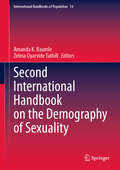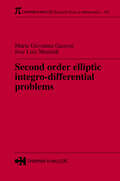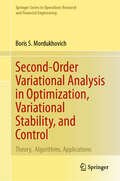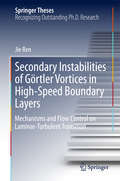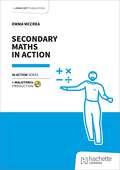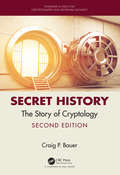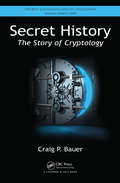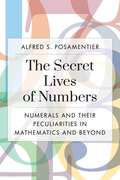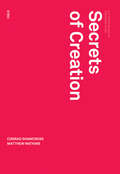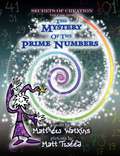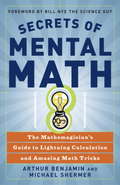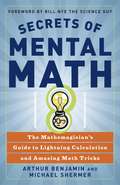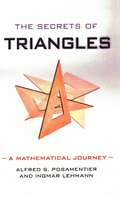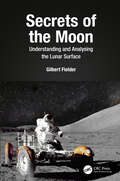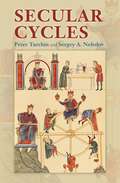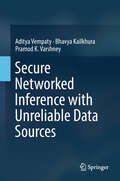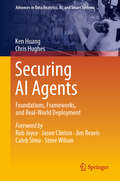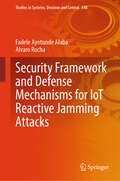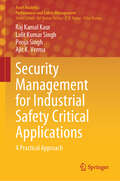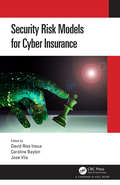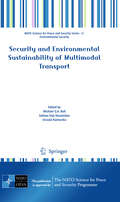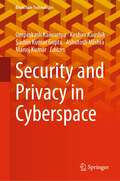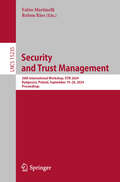- Table View
- List View
Second International Handbook on the Demography of Sexuality (International Handbooks of Population #14)
by Amanda K. Baumle Zelma Oyarvide TuthillA decade after the publication of the first International Handbook on the Demography of Sexuality, there have been fundamental shifts in how we measure sexual and gender identities and the breadth of available population-level sexuality data. The chapters in this second edition of this handbook provide guidance on methodological approaches involved in studying population sexuality, as well as insight into the ways that sexuality shapes key demographic outcomes. Chapters examine how we measure sexual identities and behaviors on surveys, sexuality changes across the life course, international perspectives on sexual behaviors and identities, and the ways that sexual identities shape families, labor market experiences, and health outcomes. Despite these developments, we still know relatively little about key demographic questions related to fertility and migration for sexual minorities, as well as about understudied topics of sexuality that fall outside of risk-focused analyses. In particular, much of our understanding of sexuality has been motivated by controlling the spread of sexually transmitted infections or adolescent pregnancies, rather than understanding motivations for sexual interactions, such as pleasure. Accordingly, although the research set forth in this book provides insight into existing knowledge of sexual behavior and of sexual minority populations, the chapters also point researchers and policymakers toward needed areas of research and data collection.
Second Order Elliptic Integro-Differential Problems (Chapman & Hall/CRC Research Notes in Mathematics Series)
by Maria Giovanna Garroni Jose Luis MenaldiThe Green function has played a key role in the analytical approach that in recent years has led to important developments in the study of stochastic processes with jumps. In this Research Note, the authors-both regarded as leading experts in the field- collect several useful results derived from the construction of the Green function and its estim
Second-Order Variational Analysis in Optimization, Variational Stability, and Control: Theory, Algorithms, Applications (Springer Series in Operations Research and Financial Engineering)
by Boris S. MordukhovichThis fundamental work is a sequel to monographs by the same author: Variational Analysis and Applications (2018) and the two Grundlehren volumes Variational Analysis and Generalized Differentiation: I Basic Theory, II Applications (2006). This present book is the first entirely devoted to second-order variational analysis with numerical algorithms and applications to practical models. It covers a wide range of topics including theoretical, numerical, and implementations that will interest researchers in analysis, applied mathematics, mathematical economics, engineering, and optimization. Inclusion of a variety of exercises and commentaries in each chapter allows the book to be used effectively in a course on this subject. This area has been well recognized as an important and rapidly developing area of nonlinear analysis and optimization with numerous applications. Consisting of 9 interrelated chapters, the book is self-contained with the inclusion of some preliminaries in Chapter 1.Results presented are useful tools for characterizations of fundamental notions of variational stability of solutions for diverse classes of problems in optimization and optimal control, the study of variational convexity of extended-real-valued functions and their specifications and variational sufficiency in optimization. Explicit calculations and important applications of second-order subdifferentials associated with the achieved characterizations of variational stability and related concepts, to the design and justification of second-order numerical algorithms for solving various classes of optimization problems, nonsmooth equations, and subgradient systems, are included. Generalized Newtonian algorithms are presented that show local and global convergence with linear, superlinear, and quadratic convergence rates. Algorithms are implemented to address interesting practical problems from the fields of machine learning, statistics, imaging, and other areas.
Secondary Instabilities of Görtler Vortices in High-Speed Boundary Layers
by Jie RenThis thesis first reveals the mechanism of Görtler instabilities and then demonstrates how transitions at hypersonic flows can be effectively controlled (either promoted or suppressed) with Görtler or Klebanoff modes. It focuses on understanding and controlling flow transitions from mild laminar to fully turbulent flows at high speeds—aspects that have become crucial at the dawn of an incredible era, in which hypersonic vehicles are becoming available. Once this occurs, it will be possible to travel from Beijing to Los Angeles within just 2 hours, and we will all live in a genuinely global village—and not just virtually, but physically.Görtler instabilities have often been used to promote flow transition in hypersonic vehicles. However, how Görtler instabilities are excited and how they evolve in hypersonic flows are questions that have yet to be answered.
Secondary Maths in Action
by Emma McCreaIn Secondary Maths in Action, experienced curriculum expert and maths teacher Emma McCrea offers insights into the complex task of teaching maths.Taking an evidence-informed stance, Emma first explores the age-old question of why we study maths and the important role it plays in our lives and in society. Next she examines several pertinent debates in maths - those of pupil grouping, mastery and gender. Finally, we are taken on a grand tour of curriculum, pedagogy and assessment as the fundamental pillars of great teaching.Additionally, the book includes four rich case studies, revisited throughout the curriculum, pedagogy, and assessment chapters, which help to showcase how these ideas can be applied in various contexts - so you can really see what it all looks like In Action.
Secondary Maths in Action
by Emma McCreaIn Secondary Maths in Action, experienced curriculum expert and maths teacher Emma McCrea offers insights into the complex task of teaching maths.Taking an evidence-informed stance, Emma first explores the age-old question of why we study maths and the important role it plays in our lives and in society. Next she examines several pertinent debates in maths - those of pupil grouping, mastery and gender. Finally, we are taken on a grand tour of curriculum, pedagogy and assessment as the fundamental pillars of great teaching.Additionally, the book includes four rich case studies, revisited throughout the curriculum, pedagogy, and assessment chapters, which help to showcase how these ideas can be applied in various contexts - so you can really see what it all looks like In Action.
Secondary Stem Educational Reform
by Carla C. JohnsonFederal and state funding agencies have invested billions of dollars into secondary STEM (Science, Technology, Education, Mathematics) educational reform over the past decade. This volume addresses the interplay of external and internal variables associated with school reform and how this dynamic has impacted many efforts.
Secret History: The Story of Cryptology (Chapman & Hall/CRC Cryptography and Network Security Series #76)
by Craig BauerThe first edition of this award-winning book attracted a wide audience. This second edition is both a joy to read and a useful classroom tool. Unlike traditional textbooks, it requires no mathematical prerequisites and can be read around the mathematics presented. If used as a textbook, the mathematics can be prioritized, with a book both students and instructors will enjoy reading. Secret History: The Story of Cryptology, Second Edition incorporates new material concerning various eras in the long history of cryptology. Much has happened concerning the political aspects of cryptology since the first edition appeared. The still unfolding story is updated here. The first edition of this book contained chapters devoted to the cracking of German and Japanese systems during World War II. Now the other side of this cipher war is also told, that is, how the United States was able to come up with systems that were never broken. The text is in two parts. Part I presents classic cryptology from ancient times through World War II. Part II examines modern computer cryptology. With numerous real-world examples and extensive references, the author skillfully balances the history with mathematical details, providing readers with a sound foundation in this dynamic field. FEATURES Presents a chronological development of key concepts Includes the Vigenère cipher, the one-time pad, transposition ciphers, Jefferson’s wheel cipher, Playfair cipher, ADFGX, matrix encryption, Enigma, Purple, and other classic methods Looks at the work of Claude Shannon, the origin of the National Security Agency, elliptic curve cryptography, the Data Encryption Standard, the Advanced Encryption Standard, public-key cryptography, and many other topics New chapters detail SIGABA and SIGSALY, successful systems used during World War II for text and speech, respectively Includes quantum cryptography and the impact of quantum computers
Secret History: The Story of Cryptology (Discrete Mathematics and Its Applications)
by Craig P. BauerWinner of an Outstanding Academic Title Award from CHOICE MagazineMost available cryptology books primarily focus on either mathematics or history. Breaking this mold, Secret History: The Story of Cryptology gives a thorough yet accessible treatment of both the mathematics and history of cryptology. Requiring minimal mathematical prerequisites, the
Secret Lives of Numbers: Numerals and Their Peculiarities in Mathematics and Beyond
by Alfred S. PosamentierWe see numbers on automobile license plates, addresses, weather reports, and, of course, on our smartphones. Yet we look at these numbers for their role as descriptors, not as an entity in and unto themselves. Each number has its own history of meaning, usage, and connotation in the larger world. The Secret Lives of Numbers takes readers on a journey through integers, considering their numerological assignments as well as their significance beyond mathematics and in the realm of popular culture. Of course we all know that the number 13 carries a certain value of unluckiness with it. The phobia of the number is called Triskaidekaphobia; Franklin Delano Roosevelt was known to invite and disinvite guests to parties to avoid having 13 people in attendance; high-rise buildings often skip the 13th floor out of superstition. There are many explanations as to how the number 13 received this negative honor, but from a mathematical point of view, the number 13 is also the smallest prime number that when its digits are reversed is also a prime number. It is honored with a place among the Fibonacci numbers and integral Pythagorean triples, as well as many other interesting and lesser-known occurrences. In The Secret Lives of Numbers, popular mathematician Alfred S. Posamentier provides short and engaging mini-biographies of more than 100 numbers, starting with 1 and featuring some especially interesting numbers –like 6,174, a number with most unusual properties –to provide readers with a more comprehensive picture of the lives of numbers both mathematically and socially. ,
Secrets of Creation: The Mystery Of The Prime Numbers (Urbanomic / Redactions)
by Robin Mackay Conrad Shawcross Matthew WatkinsAn artist and a mathematician debate, find common ground, and jointly create an assemblage that is neither (or both) an artwork and a mathematical model.A week-long residency project brought together artist Conrad Shawcross and mathematician Matthew Watkins to reflect on the ways in which artists use (or misuse) scientific and mathematical concepts. Secrets of Creation documents this fascinating meeting of worlds, presenting both the week's discussions and debates, and the project upon which Shawcross and Watkins subsequently embarked.Navigating a route that tacked between formalism and natural language, experts and laymen, quantity and quality, poetics and mechanics, Shawcross and Watkins gradually forged a shared discourse in which the concerns of the artist and those of the mathematician could find a common ground. The project ended with their joint creation of an assemblage that was neither (or both) an artwork and a mathematical model.
Secrets of Creation: The Mystery of the Prime Numbers
by Matthew WatkinsThe Mystery of the Prime Numbers uses an innovative visual approach to communicate some surprisingly advanced mathematical ideas without any need for formulas or equations. The issue of prime numbers acts as a gateway into some truly strange philosophical territory whose relevance extends well beyond mathematics.
Secrets of Mental Math: The Mathemagician's Guide to Lightning Calculation and Amazing Math Tricks
by Michael Shermer Arthur BenjaminThese simple math secrets and tricks will forever change how you look at the world of numbers. Secrets of Mental Math will have you thinking like a math genius in no time. Get ready to amaze your friends--and yourself--with incredible calculations you never thought you could master, as renowned "mathemagician" Arthur Benjamin shares his techniques for lightning-quick calculations and amazing number tricks. This book will teach you to do math in your head faster than you ever thought possible, dramatically improve your memory for numbers, and--maybe for the first time--make mathematics fun. <p><p> Yes, even you can learn to do seemingly complex equations in your head; all you need to learn are a few tricks. You'll be able to quickly multiply and divide triple digits, compute with fractions, and determine squares, cubes, and roots without blinking an eye. No matter what your age or current math ability, Secrets of Mental Math will allow you to perform fantastic feats of the mind effortlessly. This is the math they never taught you in school.<p><p> <i>Advisory: Bookshare has learned that this book offers only partial accessibility. We have kept it in the collection because it is useful for some of our members. To explore further access options with us, please contact us through the Book Quality link on the right sidebar. Benetech is actively working on projects to improve accessibility issues such as these.</i> <P> <b>There is another version of the book with mathematical expressions not rendered as images at https://www.bookshare.org/browse/book/446779</b>
Secrets of Mental Math: The Mathemagician's Guide to Lightning Calculation and Amazing Math Tricks, 1st Edition
by Michael Shermer Arthur BenjaminArthur Benjamin shares his techniques for lightning-quick calculations and amazing number tricks. This book will teach you to do math in your head faster than you ever thought possible, dramatically improve your memory for numbers, and--maybe for the first time--make mathematics fun.
Secrets of Triangles: A Mathematical Journey
by Alfred S. Posamentier Ingmar LehmannRequiring no more than a knowledge of high school mathematics and written in clear and accessible language, this book will give all readers a new insight into some of the most enjoyable and fascinating aspects of geometry. Everyone knows what a triangle is, yet very few people appreciate that the common three-sided figure holds many intriguing "secrets." For example, if a circle is inscribed in any random triangle and then three lines are drawn from the three points of tangency to the opposite vertices of the triangle, these lines will always meet at a common point-no matter what the shape of the triangle. This and many more interesting geometrical properties are revealed in this entertaining and illuminating book about geometry. Flying in the face of the common impression that mathematics is usually dry and intimidating, this book proves that this sometimes-daunting, abstract discipline can be both fun and intellectually stimulating. The authors, two veteran math educators, explore the multitude of surprising relationships connected with triangles and show some clever approaches to constructing triangles using a straightedge and a compass. Readers will learn how they can improve their problem-solving skills by performing these triangle constructions. The lines, points, and circles related to triangles harbor countless surprising relationships that are presented here in a very engaging fashion.
Secrets of the Moon: Understanding and Analysing the Lunar Surface
by Gilbert FielderSecrets of the Moon: Understanding and Analysing the Lunar Surface provides a unique account of the origin of key features on the lunar surface. Containing historical accounts and the latest observations from the field, in addition to exciting data from the Apollo manned missions, it describes the development of our current understanding of our Moon. It also explores the fracturing of the Moon, a topic not explored in other literature in the area, and contains a statistical treatment of the smaller craters of the Moon, as well as a geological treatment of the larger craters. This moderately technical account is designed to clarify and update the general thinking on the nature and origin of the most important lunar surface features for both undergraduate and research students. It may also be read by the professional scientist, especially the astronomer and the geologist who has found little time to study the Moon’s topography, in addition to the lunar amateur astronomer and even the dedicated layman with a keen interest in lunar science. The book excludes nearly all mathematical symbols in order to remain accessible to those without a formal education in the area. Key Features: Authored by an expert in the area Presents a comprehensive account of the lunar surface, from historical observations to the NASA Apollo manned missions and the latest observations and data in the field Includes a statistical and geological treatment of the craters Dr. Gilbert Fielder is Reader Emeritus at Lancaster University, United Kingdom. He performed extended teaching at Lancaster University on Planetary Science and introduced a new degree course on Remote Sensing. Prior to this, he was Principal Investigator in NASA’s Heat Capacity Mapping Programme, while continuing to head the Lunar and Planetary Unit at Lancaster until retirement. Dr. Fielder has authored several books, and presented many BBC and ITA television news programmes, as well as popular programmes with Sir Patrick Moore (on the BBC’s "The Sky at Night") and, on the occasion of the first landing of astronauts on the Moon, with David Frost as Chairman in a special programme.
Secular Cycles
by Peter Turchin Sergey A. NefedovMany historical processes exhibit recurrent patterns of change. Century-long periods of population expansion come before long periods of stagnation and decline; the dynamics of prices mirror population oscillations; and states go through strong expansionist phases followed by periods of state failure, endemic sociopolitical instability, and territorial loss. Peter Turchin and Sergey Nefedov explore the dynamics and causal connections between such demographic, economic, and political variables in agrarian societies and offer detailed explanations for these long-term oscillations--what the authors call secular cycles. Secular Cycles elaborates and expands upon the demographic-structural theory first advanced by Jack Goldstone, which provides an explanation of long-term oscillations. This book tests that theory's specific and quantitative predictions by tracing the dynamics of population numbers, prices and real wages, elite numbers and incomes, state finances, and sociopolitical instability. Turchin and Nefedov study societies in England, France, and Russia during the medieval and early modern periods, and look back at the Roman Republic and Empire. Incorporating theoretical and quantitative history, the authors examine a specific model of historical change and, more generally, investigate the utility of the dynamical systems approach in historical applications. An indispensable and groundbreaking resource for a wide variety of social scientists, Secular Cycles will interest practitioners of economic history, historical sociology, complexity studies, and demography.
Secure Networked Inference with Unreliable Data Sources
by Aditya Vempaty Bhavya Kailkhura Pramod K. VarshneyThe book presents theory and algorithms for secure networked inference in the presence of Byzantines. It derives fundamental limits of networked inference in the presence of Byzantine data and designs robust strategies to ensure reliable performance for several practical network architectures. In particular, it addresses inference (or learning) processes such as detection, estimation or classification, and parallel, hierarchical, and fully decentralized (peer-to-peer) system architectures. Furthermore, it discusses a number of new directions and heuristics to tackle the problem of design complexity in these practical network architectures for inference.
Securing AI Agents: Foundations, Frameworks, and Real-World Deployment (Advances in Data Analytics, AI, and Smart Systems)
by Chris Hughes Ken HuangThis book focuses on agentic AI security, providing a comprehensive guide to the theoretical foundations and practical techniques required to secure the increasingly prevalent AI agent systems. It examines the security challenges posed by multi-agent environments and presents real-world examples of open-source frameworks and commercial solutions to mitigate these risks. It answers key questions, including how to conduct threat modeling for agentic AI systems, how to secure communication and identity within multi-agent environments, and how to leverage open-source frameworks and commercial solutions for effective security. The book features dedicated chapters on agentic AI threat modeling, identity security, communication security in MAS (Multi-Agent Systems), red teaming, AI agents life cycle security, capability and security benchmarking using GAIA and AIR frameworks, Reinforcement Learning (RL) and security, secure agentic AI deployment strategies, innovative open source security frameworks (Cloud Security Alliance and OWASP examples), and case studies of commercial startups addressing agentic AI security challenges. It also explores the unique threat landscape of agentic AI, the challenges of securing communication and identity within multi-agent systems, and the practical application of security benchmarks and open-source frameworks. As such, the book equips cybersecurity professionals, AI developers, and researchers with the knowledge and tools to mitigate the unique security risks associated with autonomous agents and multi-agent systems.
Security Framework and Defense Mechanisms for IoT Reactive Jamming Attacks (Studies in Systems, Decision and Control #548)
by Alvaro Rocha Fadele Ayotunde AlabaThis book digs into the important confluence of cybersecurity and big data, providing insights into the ever-changing environment of cyber threats and solutions to protect these enormous databases. In the modern digital era, large amounts of data have evolved into the vital organs of businesses, providing the impetus for decision-making, creativity, and a competitive edge. Cyberattacks pose a persistent danger to this important resource since they can result in data breaches, financial losses, and harm to an organization's brand. Features of particular interest include: a. Understanding the Threat Landscape: The book gives a complete review of the many different types of cyber threats that target big data, including data breaches, ransomware attacks, and insider threats. b. Analysing Real-World Case Studies: The purpose of this section is to provide the reader with useful insights into the strategies, methods, and processes that cyber adversaries use via the in-depth examination of real-world assaults on big data. c. Strategies for Risk Mitigation: This book provides a comprehensive and actionable approach to reducing the dangers of cyberattacks on large amounts of data. It encompasses a broad variety of tactics, including network protection, encoding, and access restrictions d. Emerging Technologies: This section introduces readers to cutting-edge technologies and best practices for securing large data. e. Compliance with Regulations: The book examines the regulatory environment that governs data protection and privacy, including the General Data Protection Regulation (GDPR), the California Consumer Privacy Act (CCPA), and industry-specific requirements. f. Trends of the Future: This book covers current trends and issues in cybersecurity and gives forward-looking views into the future of big data security. This is done in recognition that the cybersecurity environment is always shifting and developing. g. Contributors of Expertise: The book includes contributions from industry practitioners, data scientists, and cybersecurity specialists who have hands-on experience defending large data settings.
Security Management for Industrial Safety Critical Applications: A Practical Approach (Asset Analytics)
by Lalit Kumar Singh Pooja Singh Raj Kamal Kaur Ajit K. VermaThe book introduces dependability (security metric) ideas, gives a general overview of the security analysis of Safety-Critical Systems (SCSs), explains why the study is necessary and defines key terms relevant to this research. It makes an effort to emphasize the significance of security in comparison to other dependability indicators and illustrates the key drivers of this research's purpose. The mathematical foundation of the security analysis process is briefly illustrated, and key mathematical terminology and concepts are presented that are crucial for the security evaluation of critical systems. This book's objective is to provide a thorough understanding of the security analysis process. It will be a research-focused book designed for undergraduate, graduate, and doctoral courses in software and cyber security. The fundamentals of reliability, security, metrics, and mathematical foundation have been covered in this book. Each technique's actual applications, along with benefits and drawbacks, are also shown. Applying each technique to the various case studies serves as a demonstration of how it works. By using the many case studies of safety-critical systems, the students can also learn different analysis approaches and how to model them. Students will be able to use these tools, in particular, on a case study of their choice to analyze system security. The book includes a comparison of various strategies and appropriate recommendations for further reading on these subjects. Moreover, this book's target audience includes software professionals who are interested in security analysis.
Security Risk Models for Cyber Insurance
by David Rios Insua Caroline Baylon Jose VilaTackling the cybersecurity challenge is a matter of survival for society at large. Cyber attacks are rapidly increasing in sophistication and magnitude—and in their destructive potential. New threats emerge regularly, the last few years having seen a ransomware boom and distributed denial-of-service attacks leveraging the Internet of Things. For organisations, the use of cybersecurity risk management is essential in order to manage these threats. Yet current frameworks have drawbacks which can lead to the suboptimal allocation of cybersecurity resources. Cyber insurance has been touted as part of the solution – based on the idea that insurers can incentivize companies to improve their cybersecurity by offering premium discounts – but cyber insurance levels remain limited. This is because companies have difficulty determining which cyber insurance products to purchase, and insurance companies struggle to accurately assess cyber risk and thus develop cyber insurance products. To deal with these challenges, this volume presents new models for cybersecurity risk management, partly based on the use of cyber insurance. It contains: A set of mathematical models for cybersecurity risk management, including (i) a model to assist companies in determining their optimal budget allocation between security products and cyber insurance and (ii) a model to assist insurers in designing cyber insurance products. The models use adversarial risk analysis to account for the behavior of threat actors (as well as the behavior of companies and insurers). To inform these models, we draw on psychological and behavioural economics studies of decision-making by individuals regarding cybersecurity and cyber insurance. We also draw on organizational decision-making studies involving cybersecurity and cyber insurance. Its theoretical and methodological findings will appeal to researchers across a wide range of cybersecurity-related disciplines including risk and decision analysis, analytics, technology management, actuarial sciences, behavioural sciences, and economics. The practical findings will help cybersecurity professionals and insurers enhance cybersecurity and cyber insurance, thus benefiting society as a whole. This book grew out of a two-year European Union-funded project under Horizons 2020, called CYBECO (Supporting Cyber Insurance from a Behavioral Choice Perspective).
Security and Environmental Sustainability of Multimodal Transport
by Michael Bell Solmaz Haji Hosseinloo Urszula KanturskaThis book is the result of a NATO Advanced Research Workshop which was held at Imperial College London in January 2009. It features contributions from a range of international experts covering topics related to the transport of hazardous materials, such as routeing and scheduling, risk assessment, security, and social and environmental exposure. There is also a broad look at the implications of climate change for transport. This unique resource offers a deep understanding of hazardous material transportation and concomitant security and environmental problems. The risks involved in the transport of dangerous goods are shown to arise mainly from the location of the sources and destinations as well as the timing of deliveries. Environmental concerns, including the implications of climate change for transport, provide a useful context for the more analytical material. The book is timely and topical as the subjects covered have become a focus for public concern in recent years, due in part to terrorist attacks on transport systems. This comprehensive reference provides examples from around the world, illustrating the diversity of regulations which apply to the handling and transport of dangerous goods. It also provides interesting insights into the global energy supply chain and describes on-going work on establishing network vulnerability.
Security and Privacy in Cyberspace (Blockchain Technologies)
by Manoj Kumar Omprakash Kaiwartya Ashutosh Mishra Keshav Kaushik Sachin Kumar GuptaThis book highlights the literature and the practical aspects to understand cybersecurity and privacy in various networks and communication devices. It provides details of emerging technologies on various networks by protecting the privacy and security of cyberspace. This book presents state-of-the-art advances in the field of cryptography and network security, cybersecurity and privacy, providing a good reference for professionals and researchers.
Security and Trust Management: 20th International Workshop, STM 2024, Bydgoszcz, Poland, September 19–20, 2024, Proceedings (Lecture Notes in Computer Science #15235)
by Fabio Martinelli Ruben RiosThis book constitutes the refereed proceedings of the 20th International Workshop on Security and Trust Management (ERCIM STM 2024), held in Bydgoszcz, Poland, during September 19–20, 2024 and co-located with ESORICS 2024 conference. The 6 full papers and 4 short papers presented in this volume were carefully reviewed and selected from 22 submissions. They were organized in topical sections as follows: Trust, Anonymity and Identity; Cryptography, Secure Computation and Formal Methods; Operating Systems and Application Security.
